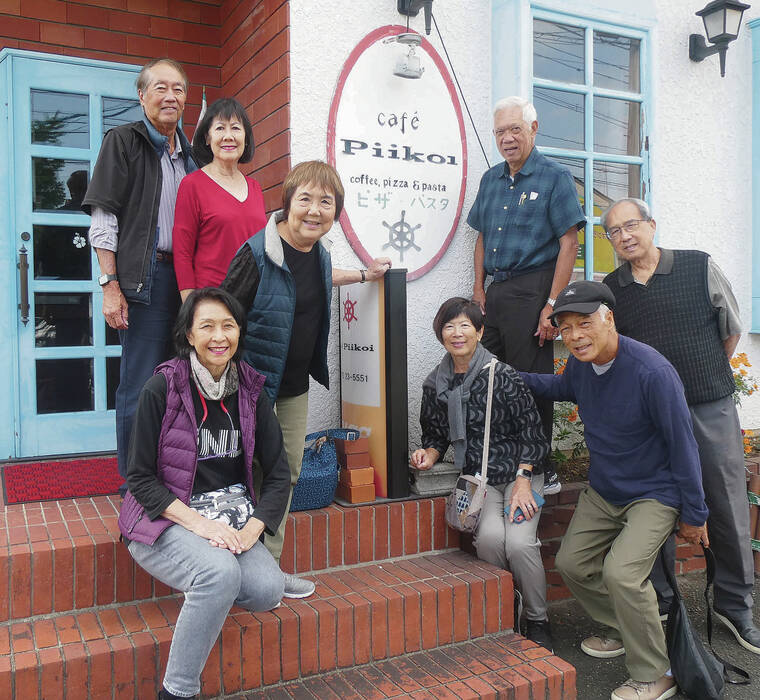In Bhutan, gross national happiness more important than GDP
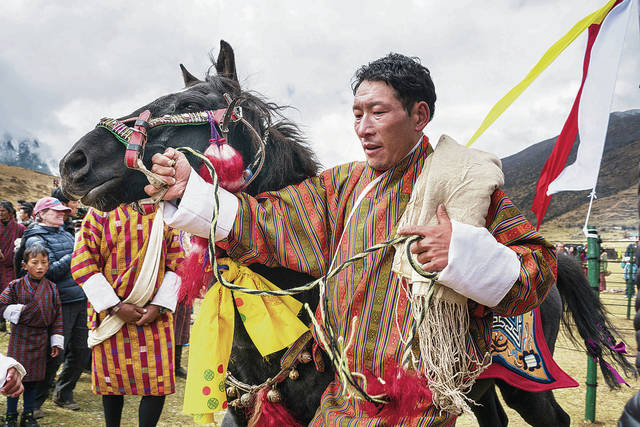
ASSOCIATED PRESS
A Layan highlander, in native dress, parades his pony, which won the horse race at the Laya Royal Highlander Festival, in Bhutan. The little ponies were festooned in ribbons, feathers and other colorful touches.
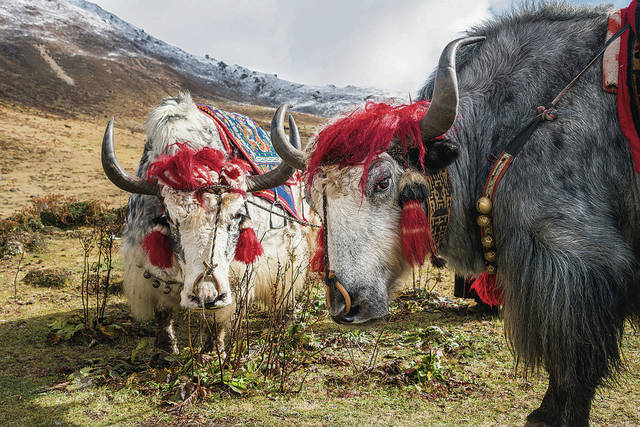
ASSOCIATED PRESS
Yaks enter in the best yak contest at the Laya Royal Highlander Festival, in the Himalayan highlands of Bhutan. Laya is one of the highest villages in Bhutan, and is the country’s primary yak-breeding area. For the festival, yaks are decorated with tassels, ribbons and colored headpieces.
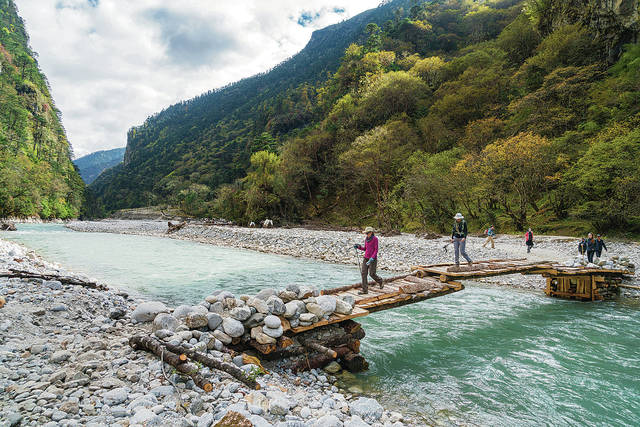
ASSOCIATED PRESS
Trekkers cross the glacier-fed Mo Chuu River on the hike from Gasa to the Laya Highlands for the second annual Royal Highlander festival. The festival is accessible only on foot, a 36-mile roundtrip up to nearly 13,000 feet altitude.
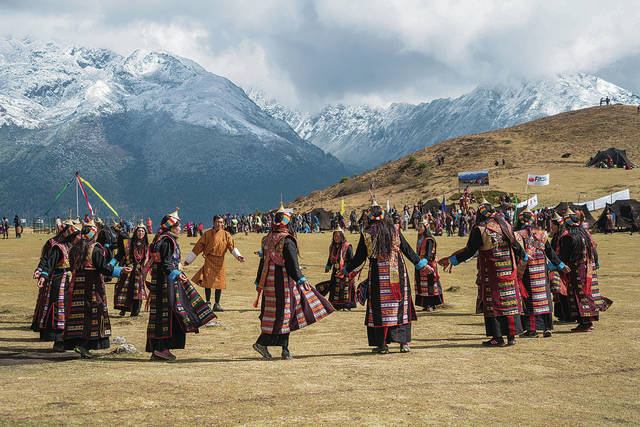
ASSOCIATED PRESS
Residents of Laya and other Bhutanese celebrate at the Royal Highlander festival by participating in a traditional dance, at nearly 13,000 feet, with the Himalayas in the background.
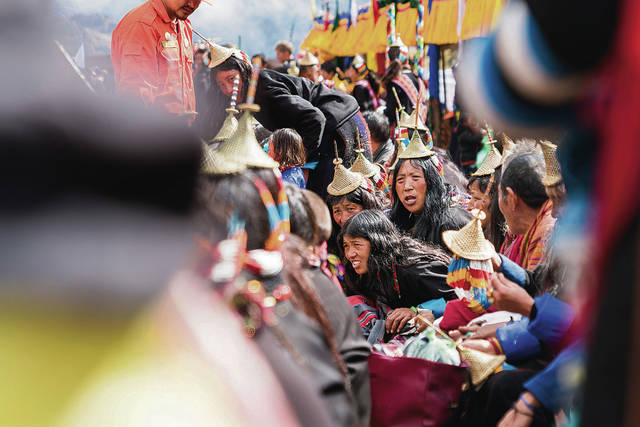
ASSOCIATED PRESS
Women from the Laya ethnic group in their native costume, much of it woven from yak wool, attend the games and events at the Laya Royal Highlander Festival in the Himalayas, in Bhutan. A woven bamboo hat, a shamu la, tops the outfit, along with heavy cats’ eye, coral and turquoise jewelry.





LAYA, Bhutan >> Prayer flags whip in the wind, flying across steep valleys and roads. Buddhist temples, stupa shrines and majestic fortresses called zhongs dot the landscape. Giant water-powered prayer wheels spin from tumbling falls. Farmers tend yaks.
Never conquered, never colonized, tiny Bhutan retains much of its deep and ancient culture. But it’s attempting to chart a unique path in today’s world: Modernize and democratize without sacrificing independence, culture or its pristine mountains and forests.
It’s also taken a unique approach to tourism, promoting itself as an “exclusive” destination through “high value, low impact” tourism. Tourists can only visit by booking through licensed tour operators with packages that cost $200 to $250 a day, depending on the season. Some of that money is earmarked by the government for health care, free schools and infrastructure. Despite the high price tag, Bhutan was listed by both The New York Times and Afar magazine on “where to go in 2018” lists.
Wedged between India and China, Bhutan is the last remaining Buddhist kingdom in the Himalayas. But the country has transitioned from absolute monarchy to a democratic, constitutional monarchy. Parliamentary elections were first held in 2008 despite resistance from Bhutanese who revered their royals.
IF YOU GO: BHUTAN
>> Booking a tour: Bhutan requires tourists to book packages worth at least $200-$250 a day, depending on the season using licensed tour operators. Most tourists visiting Bhutan come from India and other neighboring countries. Tour operators geared to Westerners include National Geographic and budget tour company Blue Poppy. Luxury operator Gray Langur, which offers the Kingdom of the Clouds 14-day trip in October, including the Royal Highlander Festival in Laya, starting at $6,400 per person, double occupancy, all-inclusive (airfare, four- and five-star hotels along with camping and homestays).
>> On the Net: For more on attractions, such as Tiger’s Nest monastery, and the cities of Thimphu and Punakha, visit tourism.gov.bt.
The country’s fourth king, and father of today’s ruler, introduced the concept of gross national happiness in the 1970s as more important than gross domestic product. The GNH measure, far from a bumper sticker slogan, embraces sustainable development, education and health, valuing societal good over economic growth. Cigarettes are banned, and Bhutan is the world’s only carbon-negative country, producing less carbon than its forests absorb.
Don't miss out on what's happening!
Stay in touch with breaking news, as it happens, conveniently in your email inbox. It's FREE!
The fifth and reigning king, Jigme Khesar Namgyel Wang-chuck (affectionately known as K-5, also the name of a local whiskey), created a festival two years ago to attract tourists to a poor region with an ethnic nomadic population. The Laya Royal Highlander Festival, held in October, includes events like yak judging, wrestling matches, pony races, native dancing and a contest for best mastiff dog.
Tourists heading to the highland festival face a 36-mile round-trip trek from 6,000 feet to more than 12,500 feet in altitude mostly on rocky, precipitous trails also used by donkeys (laden with propane tanks, tents and other supplies). Rain can turn those trails into a slippery mess of mud and poop.
The challenging route didn’t stop the king from trekking up in a few hours last October. Nor did it stop a woman in native dress — handwoven duri (skirt), top and shamu la, a golden crownlike hat — from marching up in red pumps. Most tourists, though, take two days with constant pauses to catch their breath. The payoff: breathtaking views of the Himalayas above and roaring glacier-fed rivers below.
One festival highlight is the nyagay, or strongman race (strong woman, too). Six women in yak-wool skirts dragged massive planks of wood halfway across a field, then dropped the planks and heaved 50-pound grain sacks onto the backs of their male partners. The women then climbed on the men’s backs, and the men retrieved the wood, then raced back to the starting line. All this in four minutes at an altitude of nearly 13,000 feet.
Yak-wool tents, impervious to the damp, ringed the festival field and provided protected seating. Booths offered instruction on sustainable products and practices, from animal husbandry (“use only inferior mares for mule production”) to the benefits of Bhutanese honey (bees here are healthy because there are few insecticides).
Ubiquitous Bhutanese dogs, unflappable and friendly, curled up on the field like commas and snoozed. The Merak nomads wore their signature black beanies, which have dreadlock-like braids that divert raindrops away from the face. Vendors sold yak bells, yak wool hats and purses, yak cheese wrapped in leather (smelling like a good parmigiano) and vials of the pricey fungus, cordyceps, said to be powerfully healing.
A tent decorated with gold swag and a thronelike chair was designated for the king. But he spent most of his time greeting guests warmly and without pomp. He even greeted me, reaching into his gho, a kimono-like robe, for a bottle of cordyceps, saying: “I just bought this. Would you like to have it? It is said to be very beneficial.”
Before a race where stubby ponies galloped up and down hills, feathered headdresses flying, lunch was served. Hundreds of villagers and visitors alike sat cross-legged as helpers (including royals) ladled rice, vegetable curries and hot butter tea, all compliments of the king.
The happiness quotient was as high as the sky.

